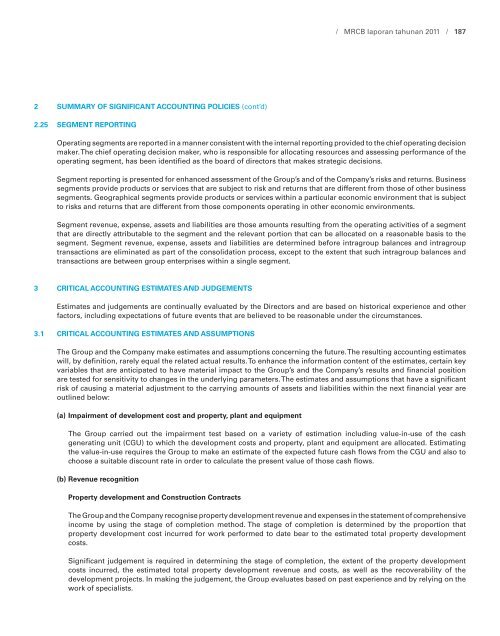Connecting the nation. and Beyond. - ChartNexus
Connecting the nation. and Beyond. - ChartNexus
Connecting the nation. and Beyond. - ChartNexus
Create successful ePaper yourself
Turn your PDF publications into a flip-book with our unique Google optimized e-Paper software.
2 SUMMARY OF SIGNIFICANT ACCOUNTING POLICIES (cont’d)<br />
2.25 SEGMENT REPORTING<br />
Operating segments are reported in a manner consistent with <strong>the</strong> internal reporting provided to <strong>the</strong> chief operating decision<br />
maker. The chief operating decision maker, who is responsible for allocating resources <strong>and</strong> assessing performance of <strong>the</strong><br />
operating segment, has been identified as <strong>the</strong> board of directors that makes strategic decisions.<br />
Segment reporting is presented for enhanced assessment of <strong>the</strong> Group’s <strong>and</strong> of <strong>the</strong> Company’s risks <strong>and</strong> returns. Business<br />
segments provide products or services that are subject to risk <strong>and</strong> returns that are different from those of o<strong>the</strong>r business<br />
segments. Geographical segments provide products or services within a particular economic environment that is subject<br />
to risks <strong>and</strong> returns that are different from those components operating in o<strong>the</strong>r economic environments.<br />
Segment revenue, expense, assets <strong>and</strong> liabilities are those amounts resulting from <strong>the</strong> operating activities of a segment<br />
that are directly attributable to <strong>the</strong> segment <strong>and</strong> <strong>the</strong> relevant portion that can be allocated on a reasonable basis to <strong>the</strong><br />
segment. Segment revenue, expense, assets <strong>and</strong> liabilities are determined before intragroup balances <strong>and</strong> intragroup<br />
transactions are eliminated as part of <strong>the</strong> consolidation process, except to <strong>the</strong> extent that such intragroup balances <strong>and</strong><br />
transactions are between group enterprises within a single segment.<br />
3 CRITICAL ACCOUNTING ESTIMATES AND JUDGEMENTS<br />
Estimates <strong>and</strong> judgements are continually evaluated by <strong>the</strong> Directors <strong>and</strong> are based on historical experience <strong>and</strong> o<strong>the</strong>r<br />
factors, including expectations of future events that are believed to be reasonable under <strong>the</strong> circumstances.<br />
3.1 CRITICAL ACCOUNTING ESTIMATES AND ASSUMPTIONS<br />
The Group <strong>and</strong> <strong>the</strong> Company make estimates <strong>and</strong> assumptions concerning <strong>the</strong> future. The resulting accounting estimates<br />
will, by definition, rarely equal <strong>the</strong> related actual results. To enhance <strong>the</strong> information content of <strong>the</strong> estimates, certain key<br />
variables that are anticipated to have material impact to <strong>the</strong> Group’s <strong>and</strong> <strong>the</strong> Company’s results <strong>and</strong> financial position<br />
are tested for sensitivity to changes in <strong>the</strong> underlying parameters. The estimates <strong>and</strong> assumptions that have a significant<br />
risk of causing a material adjustment to <strong>the</strong> carrying amounts of assets <strong>and</strong> liabilities within <strong>the</strong> next financial year are<br />
outlined below:<br />
(a) Impairment of development cost <strong>and</strong> property, plant <strong>and</strong> equipment<br />
The Group carried out <strong>the</strong> impairment test based on a variety of estimation including value-in-use of <strong>the</strong> cash<br />
generating unit (CGU) to which <strong>the</strong> development costs <strong>and</strong> property, plant <strong>and</strong> equipment are allocated. Estimating<br />
<strong>the</strong> value-in-use requires <strong>the</strong> Group to make an estimate of <strong>the</strong> expected future cash flows from <strong>the</strong> CGU <strong>and</strong> also to<br />
choose a suitable discount rate in order to calculate <strong>the</strong> present value of those cash flows.<br />
(b) Revenue recognition<br />
Property development <strong>and</strong> Construction Contracts<br />
/ MRCB laporan tahunan 2011 / 187<br />
The Group <strong>and</strong> <strong>the</strong> Company recognise property development revenue <strong>and</strong> expenses in <strong>the</strong> statement of comprehensive<br />
income by using <strong>the</strong> stage of completion method. The stage of completion is determined by <strong>the</strong> proportion that<br />
property development cost incurred for work performed to date bear to <strong>the</strong> estimated total property development<br />
costs.<br />
Significant judgement is required in determining <strong>the</strong> stage of completion, <strong>the</strong> extent of <strong>the</strong> property development<br />
costs incurred, <strong>the</strong> estimated total property development revenue <strong>and</strong> costs, as well as <strong>the</strong> recoverability of <strong>the</strong><br />
development projects. In making <strong>the</strong> judgement, <strong>the</strong> Group evaluates based on past experience <strong>and</strong> by relying on <strong>the</strong><br />
work of specialists.

















